|
The AIF & NZEF in the Great War
|
| Choose a particular specialised subject from
those listed right or read the page for an overview of the events . . |
First World
War Nominal Roll (Australia)
Details of members of the AIF who served overseas
during the First World War.
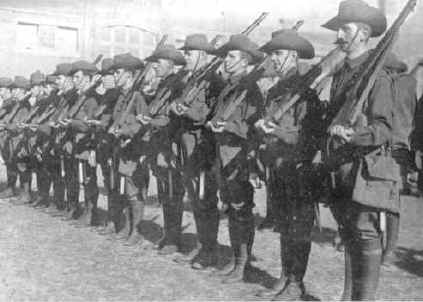
Men of the
ANMEF (see
below)
also sometimes
called AN&MEF
World War I - Background
- The causes of the war that broke out in Europe on 4 August were
numerous and complex. For Australia, the broader international issues were
perhaps less important than the simple fact that the British Empire was at
war.
- As the Australian Government had been warned of the likely outbreak
of hostilities, Australia’s defences were already being prepared when
the war started.
- Imperial defence plans assumed that the Royal Australian
Navy would operate as an integral part of the Royal Navy where ever it was
required. Such an assumption could not be made about the Army. The Defence
Act restricted the Australian Army to service within Australian territory
for home defence purposes.
- To enable Australian participation in a
European land war, a separate all-volunteer force would have to be
recruited specifically for overseas service.
- Following the declaration of war on 4 August 1914, the Fisher
Government's pledge of full support for Britain led to the raising of what
became known as the Australian Imperial Force (AIF ).
- Recruiting started on 10 August and by November 1914, 20,000 members of an
infantry division and a light horse brigade, under the respective commands
of Major General (later Sir )William T. Bridges and Colonel (later
Lieutenant General Sir) Harry Chauvel, accompanied by New Zealand troops,
were on their way to Egypt.
|

Sub category Index
|
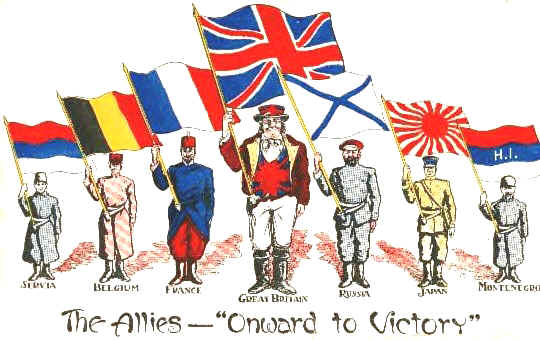
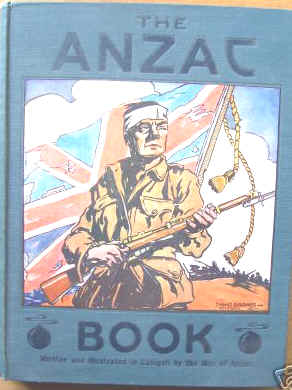 |
The "Anzac
Book" was written by the men in the trenches of Gallipoli in
1915.
Not afterwards when time and other
views have re-shaped opinion/s.
When the shots were actually being
fired, when the shrapnel was falling.
In that sense it is probably
unique in world history.
It can be seen IN
FULL HERE

|
|
Who were "The
Allies" and when did they enter the war? |
|
1914
|
1915
|
1916
|
1917
|
1918
|
|
Serbia
Russia
France
Belgium
Japan
Montenegro
Great Britain
Australia
New Zealand
Canada
South Africa
|
Italy
|
Portugal
Romania
|
USA
Cuba
Brazil
Panama
Thailand
Liberia
China
|
Greece
Guatemala
Nicaragua
Costa Rica
Haiti
|
| The
major brunt of the war effort on the Allied side was borne by France,
Great Britain and her four Dominion nations plus Russia, Serbia and
Belgium. These five nations alone of the twenty-six Allies accounted
for over 91% of the 16.2 million Allied military casualties. While
fifteen more nations joined the Allied cause during the course of the
war, the only two additions that had substantive military impact on
the ultimate Allied victory were the entry of the Kingdom of Italy in
May 1915 and the United States in April 1917. |
It is perhaps surprising that the first round fired by any Army of the
British Empire, including Great Britain, in World War I was by the gunners
of Fort Nepean. Situated at the entrance to Port Phillip Bay, Victoria,
the Fort fired one round from its 6 inch Mark VII to stop the German
freighter Pfalz escaping from Port Phillip a few hours after the
declaration of war.
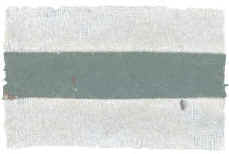 |
Grey horizontally aligned
rectangular colour patch for Tropical Expeditionary Force, with a
horizontally aligned central green strip. Colour patch worn by Army
members of the 1st Australian Naval and Military Expeditionary Force
(AN&MEF) to
New Guinea. This patch was worn by Second Lieutenant Arthur Lionel Keith
Cooper. He later enlisted in the AIF on 1 July 1918 to undertake further
officer training in England. He was attached to 11th General Service
Reinforcements when he died from Spanish influenza at Tidworth in
England on 14 November 1918. |
Before the AIF sailed however, another all volunteer force had already
been in action. The strategic importance of German wireless stations in
New Guinea and the surrounding islands led British authorities to ask the
Australian Government to destroy them as a matter of urgency.
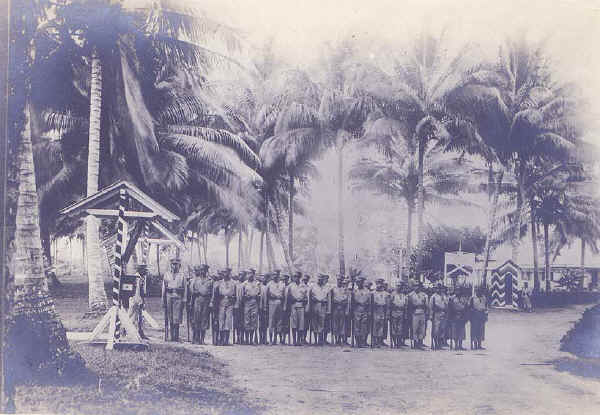 |
| Papuan
troops on New Britain under German command undertake drill just
prior to the outbreak of war. |
To carry out
this task, the Australian Government raised an expeditionary force of 1500
men under the command of Colonel W. Holmes - the Australian Naval and
Military Expeditionary Force. This mixed force of naval reservists and
soldiers had, by October 1914, forced the surrender of the garrison and
taken possession of German New Guinea and the neighbouring islands of the
Bismarck Archipelago. (Subsequently, on 17 December 1920, the Australian mandate over this
territory was granted by the League of Nations.
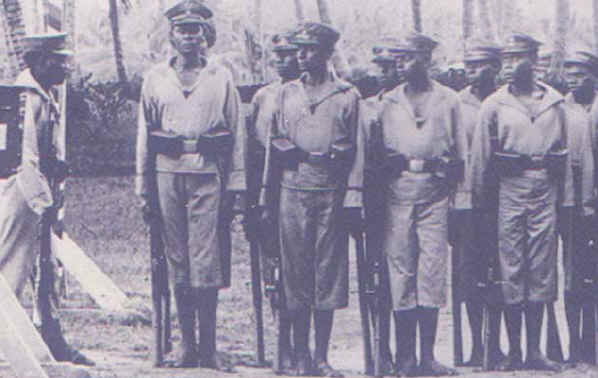 |
|
Papuan troops on
New Britain under German command undertake drill just prior to the
outbreak of war (2). |
-
The Australian Naval and Military
Expeditionary Forces took two aircraft with them to support their
operations in New Guinea. The two aircraft, a Maurice Farman
Floatplane and a BE2a were taken from the Central Flying School in
Point Cook. The German forces in New Guinea were quickly overrun and
the two aircraft remained in their crates until returned to Australia.
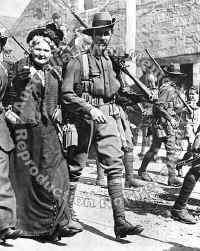 |
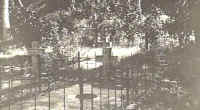 |
| Sydney, NSW,
1914-08-14. Her soldier son.
The first batch of Australian troops, 1 Australian Naval and
Military Expeditionary Force (ANMEF) to leave Australia for Rabaul.
They are seen marching to the wharf, one cheerful mother beside her
son. (donor Sydney Mail) |
Original
burial place of Dr. Pockley and Able Seamen Courtney, Williams, and
Street, killed at the landing 1914 of the Australian Naval and
Military Expeditionary Force (ANMEF) at German New Guinea. |
 |
Given
to the family of 121 Able Seaman (Signaller) Robert David Moffatt, Royal
Australian Naval Reserve (RANR).
Moffatt, born in England in 1894, worked
as an engineer in Sydney and served on HMAS Australia.
On 11 September 1914, whilst serving in
the Australian Naval and Military Expeditionary Force (AN&MEF)in the
advance from Kabakaul to Bitapaka, in New Britain, he was shot and killed
by a native sniper.
He was twenty years old. Image
& details from AWM  |
| When the Australian
Naval and Military Expeditionary Force took control of German New
Guinea in September 1914 the new administration was presented with
the problem of maintaining the economic stability of the
colony.
The administration decided to
retain the German mark as legal tender during the period of transition' |
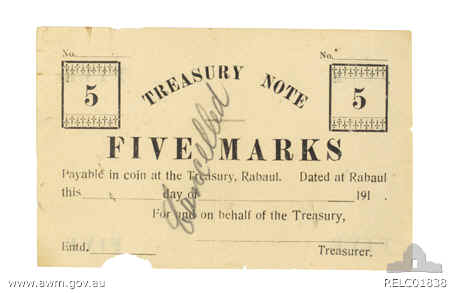 |
| As
a result of a currency shortage, had these treasury notes printed.
The decision to not only retain the foreign currency, but to issue
Australian banknotes in German marks was met with outrage at home.
Only a small number were released into circulation and each valid
note was hand-signed and dated. They were recalled early in January
1915, less than five months after they were first printed. |
World War I - Gallipoli
While still training in the Egyptian desert late in 1914, the 1st
Australian
Division and the New Zealand and Australian Division (NZ and A Division)
(which later included the 1st Light Horse Brigade) were formed
into the Australian and New Zealand Army Corps (ANZAC), under the command
of Lieutenant General William R (Field Marshal, the Lord) Birdwood. Together with British troops, the ANZAC forces had been kept in Egypt
because of unsuitable training facilities in England and, later, to help
protect the Suez Canal, following Turkey’s entry into the war in October
1914.
In the face of lack of progress on the Western Front in late 1914, the
British War Council suggested that Germany could best be defeated by
attacks on her weaker allies, Austria-Hungary and Turkey. Initially, the
attack on Turkey was to be a naval operation but, after abortive naval
attempts to force the Dardanelles in February and March, the British
Cabinet agreed that land forces could be used. The ANZACS, together with British formations, landed north of Gaba Tepe
(the landing area later known as Anzac Cove) and at Cape Helles on the
Gallipoli Peninsula. They were to capture the Turkish forts commanding the
narrow straits and force open the way to the Turkish capital,
Constantinople.
French forces attacked the Turkish positions on the Asia Minor side of the
Dardanelles. Later reinforcements included the dismounted Australian Light
Horse and New Zealand Mounted Brigades at Anzac Cove
and another British corps at Suvla Bay.
The campaign was an heroic but costly failure. In December, it was
decided to evacuate the entire force from Gallipoli. On 19 and 20 December, the evacuation of Anzac and Suvla was completed
with the last British troops leaving Cape Helles by 8 January 1916. The
entire operation evacuated 142,000 men with negligible casualties.
-
Australian casualties for the campaign were 26,111, comprising 1007
officers and 25,104 other ranks. Of these, 362 officers and 7779 men were
killed in action, died of wounds or succumbed to disease.
World War I - Western Front
By early 1916, recruiting in Australia had made it possible to replace
the ANZAC losses. The AIF in Egypt was expanded to four divisions with a
fifth being raised in Australia. The overseas divisions were organised
into I ANZAC Corps (1st and 2nd Australian
Divisions, and the New Zealand Division) and II ANZAC Corps (4th
and 5th Australian Divisions).58 Beginning in March
the troops were moved to France, and by July and August were heavily
involved on the Western Front. The 5th Division was the first
to engage the Germans on 5 July 1916 in a small but bloody engagement at
Fromelles in northern France. Shortly after, the 1st, 2nd
and 4th Divisions became embroiled in the first Somme
offensive, at Pozieres and Moquet Farm.
In the following year, 1917, the Australians were again heavily
engaged, in March at Bapaume, in May and June at Bullecourt and Messines,
and from September to November in the great battles of the Ypres offensive
- Menin Road, Polygon Wood, Broodseinde, Poelcapelle and Passchendaele.
In March and April 1918, the Australian Corps took a prominent part in
preventing the capture of Amiens, Hazebrouck and Villers-Bretonneux,
during the German 'Michael' offensive. During the final allied offensives
of the war, it was engaged at Mont St Quentin and Albert, and in the
penetration of the Hindenburg Line.
The AIF strength in France was maintained at some 117,000 men.
-
Its battle casualties for the three years of trench warfare between 1916
and 18 were over 181,000; of whom over 46,000 died. Another 114,000 were
wounded, 16,000 gassed and nearly 4,000 were taken prisoners of war. In
terms of total deaths per 1000 men mobilised, the AIF figure was 145 - the
highest of all the British Commonwealth armies.
World War I - Sinai, Palestine and Syria
In March 1916, the ANZAC Mounted Division was formed, from the 1st,
2nd and 3rd Light Horse Brigades and the New Zealand
Mounted Rifles Brigade, in Egypt. It was commanded by Major General (later
Lieutenant General Sir) Harry G. Chauvel.
The Corps played a prominent part in the capture of Jerusalem in
December.
Despite the loss of many experienced troops, the Corps defeated a
determined attack by the German Asia Corps at Abu Tellul in April. During
September, the Corps played an important part in the advance to Haifa and
Semakh, entering Damascus on 1 October. Turkey signed an armistice at the
end of that month, by which time Corps units had reached Aleppo.
|











